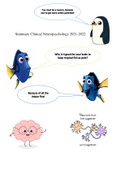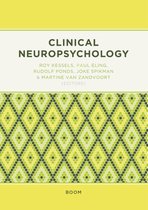Summary Clinical Neuropsychology 2021-2022
, 2
Part I
An Introduction to Neuropsychology
, 3
1. Clinical Neuropsychology: a historical outline
1.1 Introduction
The connection between brain and behaviour was laid in antiquity.
- Hippocrates: All abnormal behaviours & emotions stem from the brain
- Greeks/Romans: four humours (blood, phlegm, yellow bile & black bile) need to be balanced
in the body & brain (written down by Claudius Galen)
- Up until 14th century, Galen’s writing was taken for truth. Renaissance → new scientific
insights
- Descartes (17th): Dualism with pineal gland
- Frans Joseph Gall (19th): location of many mental organs in grey and white matter.
Unfortunately resulted in phrenology.
- Clinico-anatomical method: studying cognitive loss of function in certain areas and, post-
mortem, linking the lesion location to the type of functional impairment.
- Professionalisation of neuropsychology into an independent scientific field (20th century,
mostly US)
1.2 Cell theory
Psychikon hegemonikon or spiritus animalis: humans are the only being with the type of soul that
could distinguish between good and bad. Plants only have souls for food intake, animals have souls
for food intake and interaction with the environment.
Cell theory assumed that the mind was located in the ventricles – then called cells. The first cell
received information from the senses, the second interpreted the image, both cognitively and
affectively, and the third was the memory. It was a (very) general system of information processing.
Personality used to be called character. Physiognomy, meaning the interpretation of one’s face,
assumed that the shape of a person’s face and body reflected their character. Lavater made
physiognomy “popular” and physiognomy motivated Gall to develop his new approach involving
individual differences.
1.3 Descartes: an undivided mind
Descartes: people are composed of the body (res extensa) and the mind (res cogitans). He believed
that the mind was not material and was located in the pineal gland. He saw the mind as a manager that
interacted with the body via nerves.
1.4 Gall and the localisation issue
Gall did not believe in physiognomy and wanted to focus on the construction and function of the
brain. Although the resulting phrenology craze turned out incorrect, his ideas form the basis of
contemporary neuroscience.
He claimed brain functions were highly localised, independent and located in the cortex. He assumed
that people vary in aptitude for certain functions: the more aptitude, the larger the size of the related
area in the brain. He assumed this was the same for all people. This could be measured by feeling
lumps on the skull or by looking at the effects of brain injury.
1.5 The clinico-anatomical method
The clinico-anatomical method was used by Bouillaud to test localisation ideas by charting the
specific loss of function in patients with focal encephalopathy. Broca used this method to present his
, 4
case about Broca’s language area. He also assumed that language was located in the left side of the
brain, whilst physiologists of the time believed brain functions to be equally present in both
hemispheres.
In the years after Broca’s research, the idea emerged that language could be regarded as a set of
functions as opposed to just one. Wernicke located a separate centre for word production. According
to his model, a disorder could be caused either by a lesion in a centre or by a lesion in a connecting
pathway (a disconnection). Wernicke did not believe in Gall’s collection of functions, but regarded
the brain as an instrument in which sensory stimuli were linked to motor reactions. This was similar to
the English associationism.
Associationism was the empiricist idea that everything was learned through the principle of
association. Within this framework there was room for innate functions. The associationist John
Hughlings Jackson stated that Broca should not confuse the location of a lesion that resulted in a
specific loss with the location of that function.
1.6 Holism
Holists believed, contrary to the localisation movement, that areas of the brain generally worked
together for a particular function. They believed in fields or areas that had overlap and coherence.
During the Gestalt movement in Germany, Goldstein contended that sound functioning of the brain
was of paramount importance in order to be able to reflect on incoming stimuli instead of simply
reacting directly to them: the abstract attitude.
1.7 Luria: a global model
Luria sought a balance between holistic and localizationist views. The brain is a single complex
functional system with various subsystems. It is the result of interaction with the environment and can
change during a child’s development. Emphasis was placed on the flexibility and adaptability of the
brain. Some localisation exists, but the way in which the brain performs is very flexible.
Luria classified the functional architecture of the brain into three broad groups:
- 3 continually interacting functional units: activation (subcortical), input (posterior) and output
(anterior)
- 3 hierarchically organised levels of processing related to primary (occipital, temporal, motor
areas), secondary (modality-specific support areas) and tertiary (TPJ, frontal cortex, most
“human”) zones in the brain
- Behaviour that is (l) or is not (r) regulated by language processes, related to the left and right
hemisphere
His serial processing hypothesis, based on this classification, was incorrect.
Luria believed the left hemisphere to be the dominant half of the brain because of the use of internal
speech for the regulation of functions.
1.8 An initial impulse: the test battery
The Halstead-Reitan Neuropsychological Battery was the first neuropsychological test battery. There
was no conceptual basis for it and it was basically a screening tool to assess aspects of cognitive
functioning.
The Luria-Nebraska Neuropsychological Battery was developed by Golden and based on Luria’s
ideas.






